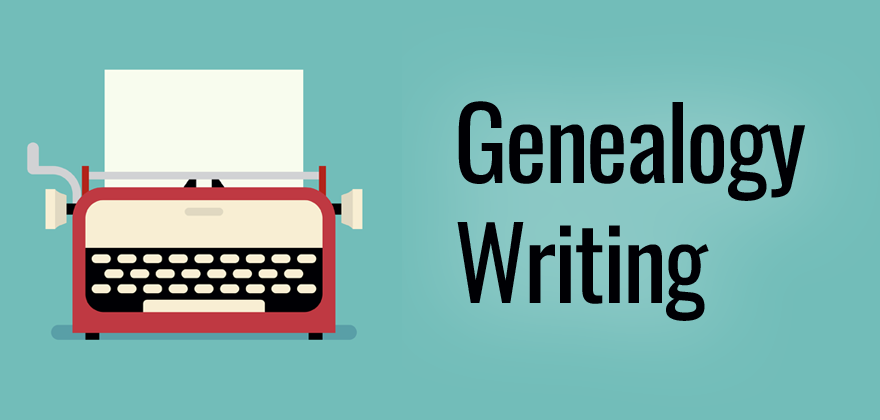Have you been trying to find a way to share your family history research with others, but don’t know where to start?
Genealogy and writing go hand-in-hand, and there are many ways to express and organize your family tree discoveries on paper!
This article will introduce and compare several different types of genealogy writing projects, provide some important tips, and include a list of helpful references to learn how to write a family history.
Why you should start writing now
There are numerous benefits to organizing your research findings through a writing project. Writing allows you to share your discoveries with family and friends. Other genealogists and enthusiasts may enjoy reading your work, or find value for their own brick wall research. Writing down your findings allows you to organize your thoughts and preserve your family history for future generations.
Writing is a natural part of the research process and is an excellent way to sharpen your skills. It can help you notice unresolved conflicts- for example, a birth or death date for an ancestor not matching between two particular records. Writing can help reveal holes in your research- for example, you may realize that you never located a marriage record for a particular couple. It also helps pinpoint unsourced facts- pieces of information that have no source attached to them, or you cannot recall where you located that information. Logging your sources and citing facts are critical components of genealogical writing and analysis.
When drawing a conclusion about an ancestor based on your research, writing down what you know can also reveal whether you have enough evidence to support that conclusion. Did you base your assumption on information found in one source, or by studying and comparing several sources? Genealogy writing projects can help hone your analysis skills and strengthen your research abilities.
Who is the audience?
When defining the “audience” for a writing project, consider who would be most likely to enjoy reading your work or find value in it. Many genealogists choose to write family history narratives to share with family members and friends, or to inform the larger genealogical community about their work. More experienced genealogists often create case studies or proof arguments for peer review, and to help teach others about their successful research methods. Writing options such as research logs and detailed reports are usually intended for the researcher’s use or for a more limited audience.
Make sure your writing is clear and understandable, so that the reader can follow your research process step-by-step. Your family narrative must has a linear flow so the reader can follow the story. Starting with an outline can help the writing process, and having a fellow family history peer (or two) proofread your work and offer feedback is highly encouraged.
Citations
It is important to use citations in any writing project. Citations help the writer keep track of their research sources, and they help the reader understand where and how the writer gathered their information. Citations lend credibility to your work. Creating citations and footnotes may seem like an overwhelming task, but once you learn the process for creating citations, they will soon become second nature. Family historians that are ready to create their own writing projects should obtain a copy of Evidence Explained: Citing History Sources from Artifacts to Cyberspace by Elizabeth Shown Mills. Evidence Explained is the go-to citation reference for professional genealogists, providing citation formats for dozens of different types of sources- from old, archived letters and manuscripts to websites and blogs. Another excellent guide is Mastering Genealogical Documentation by Tomas W. Jones. Dr. Jones breaks down the citation and documentation process in an easy-to-follow workbook that provides numerous skill-building exercises.
Types of genealogical writing projects
Next, we’ll compare several different types of family history writing projects, their uses, and how they can help your research.
First, a quick note about family tree software.
Although some family tree software programs can generate a report based on the information you input into your family tree, this type of automated data is not considered a written genealogical report. The software cannot compare evidence and draw informed conclusions; this “human” element of analysis is required to create a quality report. However, family tree software reports can be useful as a reference tool when compiling data and sources for a writing project.
Family histories and sketches
What are they– The most popular option for genealogical writing, family histories and sketches can be narrow, focusing on one ancestor’s life- or they can be broad, focusing on an entire branch of a family. Family histories can be very detailed, citing exact names and dates and tracking an ancestor’s appearance in records over a lifetime- or sketches can be a study of an ancestor or family during a particular event or period of time.
Audience– Family histories are intended to be shared with family members or other researchers. They can be published in genealogical publications and magazines as well. Family historians love to hear interesting stories about others’ ancestors- don’t be afraid to submit your family story to your local genealogical society’s journal or magazine!
When and Why to write them- Family histories are a great option for newer family historians as they are easier to write, and can be expanded as you discover new facts. Family histories can be one of the more creative forms of genealogical writing, as you can include all of the interesting facts about an ancestor’s life. The researcher’s methodology and analysis is not usually included in a family history- the writing should only focus on the family/ancestor. Family histories are a great way to preserve your ancestor’s story and dive into the world of genealogical writing!
Research logs
What are they- Research logs are incredibly helpful, as they help keep track of where you have researched and what you found. Logs help you avoid duplicating research and aid in planning future searches, whether online or at a repository. Research logs are not intended to be a finished, polished product; they are used as a reference and tracking tool.
Audience- Usually only for the researcher, unless you are doing research for someone else- in which case you should be logging your work to include as part of a research report.
When and Why to write them- It is a good habit to utilize a research log anytime you are conducting research. Logs can help you make the most of your research time, and they are also valuable as a quick reference when creating citations. Logs can be as simple as a spreadsheet listing the date, where you went, and the results you found- or you can find links to many various and customizable research logs and forms on the FamilySearch Wiki.
Research reports
What are they- The goal of a research report is to answer a specific genealogical research question. Finished reports provide a summary of the research conducted, a list of sources used, and recommendations for additional research. Research reports are most often used by professional genealogists as a finished product for their clients, but they can be helpful for the genealogist’s own research goals as well.
Audience– Reports are usually intended for a select person or group, and they should be a neat, finished product. Sources should be presented in a bibliography, and facts stated in the summary should be cited. Reports created just for personal use should also be neatly written, to help you easily reference past research and gather thoughts and ideas for future research.
When and Why to write them– Reports are always a good option when conducting research for others who just want a particular question answered- for example, when and where a particular couple married. Research reports “stick to the facts” and do not usually provide a lot of narrative or speculative details. For those that are wary of taking on a broader family history narrative, a research report that focuses on a particular fact of an ancestor’s life may be a great option.
Proof arguments & proof summaries
What are they- Proof arguments and proof summaries are written by genealogists to help support their conclusions about a specific ancestral fact.Proofs focus on the analysis and methodology aspect of genealogical research, not on the ancestor’s life narrative. Proofs help to demonstrate that the genealogist conducted thorough and sound research, which is part of the Genealogical Proof Standard- the process followed by professional genealogists to reach a sound research conclusion.
A proof summary is used when there is no conflicting evidence- for example, all sources found state that James White was born on 9 September 1760 in Groton, Connecticut. The genealogist will create a summary about the type of sources they located, the information provided within, and how they analyzed the evidence to conclude that this birth date is correct.
A proof argument is used when a genealogist finds conflicting evidence for a particular fact, and they must then “prove” that their conclusion is correct. For example, some sources state that James White was born 9 September 1760 in Groton Connecticut, but other sources state that he was born 29 September 1768. The “conflicting” evidence must be resolved- for example, was there a typo repeated in several sources? Was handwriting mis-read by a transcriber? Was some of the information secondhand or not reliable? The genealogist must provide a detailed analysis to defend their conclusion.
Audience– Proof summaries and arguments are an advanced form of genealogical writing, and require a thorough understanding of genealogical research and analysis. Proof arguments are often published in scholarly magazines such as the National Genealogical Society Quarterly so that other professionals can review and learn from the work. Writing proofs can be excellent practice for family historians so that they can better understand the analysis process and learn how to look more closely at genealogical clues.
When and Why to write them- Proof arguments are an excellent option when you stumble upon conflicting evidence and need to break down the information for further study. When all sources agree, proof summaries can help you move through the evidence step-by-step to ensure that no important information was missed. An excellent reference to learn about genealogical analysis is Mastering Genealogical Proof by Thomas W. Jones. Similar to Mastering Genealogical Documentation, this workbook provides work study examples and plenty of writing exercises, to help the reader grasp the components of the Genealogical Proof Standard.
Case studies
What are they- Think of them as a family sketch and proof summary/argument combined. Case studies are narratives with a purpose- they demonstrate how a genealogist overcame a brick wall. Case studies are very helpful as a learning tool for others who may be stuck in a similar situation with their own research.
Audience- Case studies are intended to be teaching articles for others to read and learn. As such, they should be well polished, well analyzed, and include citations. It is recommended that other genealogists proofread your work to make sure that the article is easy to follow and the research process is accurate- you want to make sure that readers can retrace your steps.
When and why to write them- Case studies are often written by seasoned professionals to demonstrate how a particularly difficult case was solved, and are often published in genealogical magazines and journals. Genealogical speakers often use case studies in their lectures as well. One thing most genealogists enjoy is sharing their discoveries to help others!
Further Reading
- Elizabeth Shown Mills, Evidence Explained: Citing History Sources from Artifacts to Cyberspace (Third Edition), published by Genealogical Publishing Company, 2015
- Thomas W. Jones, Mastering Genealogical Documentation, published by National Genealogical Society, 2017
- Thomas W. Jones, Mastering Genealogical Proof, published by National Genealogical Society, 2013
- “How to Write a Genealogy Research Report,” Family Tree Magazine
- The Board for Certification of Genealogists provides many excellent, professionally-written genealogical writing examples on their website, including research reports, case studies, and family histories.
Writing is a terrific option for genealogy professionals and hobbyists alike- and anyone can write! Don’t be afraid to start writing today to preserve your unique family story for future generations!



